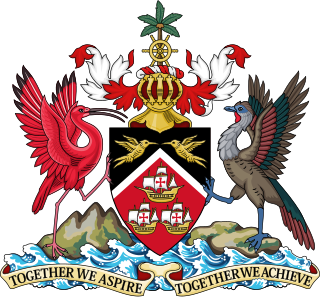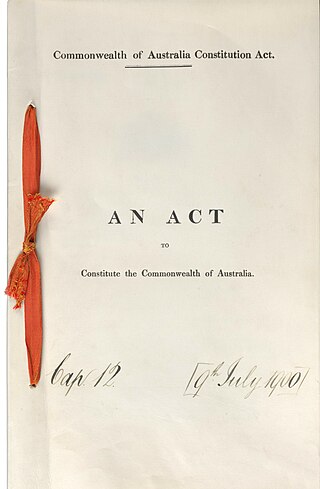
The governor-general of Australia is the representative of the monarch of Australia, currently King Charles III. They have many constitutional and ceremonial roles in the Australian political system, in which they act independently, not as monarch's delegate or agent. They also have a significant community role, through recognising meritorious individuals and groups, and representing the nation as a whole. The current governor-general is Sam Mostyn.
A head of state is the public persona of a sovereign state. The specific naming of the head of state depends on the country's form of government and separation of powers; the head of state may be a ceremonial figurehead or concurrently the head of government and more.

Politics in Jamaica takes place in the framework of a representative parliamentary democratic constitutional monarchy. The 1962 Constitution of Jamaica established a parliamentary system whose political and legal traditions closely follow those of the United Kingdom. As the head of state, King Charles III - on the advice of the Prime Minister of Jamaica - appoints a governor-general as his representative in Jamaica. The governor-general has a largely ceremonial role, with their parliamentary function consisting simply of granting royal assent to bills which have passed Parliament. Jamaica constitutes an independent Commonwealth realm.
In a parliamentary or semi-presidential system of government, a reserve power, also known as discretionary power, is a power that may be exercised by the head of state without the approval of another branch or part of the government. Unlike in a presidential system of government, the head of state is generally constrained by the cabinet or the legislature in a parliamentary system, and most reserve powers are usable only in certain exceptional circumstances.

A commander-in-chief or supreme commander is the person who exercises supreme command and control over an armed force or a military branch. As a technical term, it refers to military competencies that reside in a country's executive leadership, a head of state, head of government, or other designated government official.

The president of the Republic of Trinidad and Tobago is the head of state of Trinidad and Tobago and the commander-in-chief of the Trinidad and Tobago Defence Force. The office was established when the country became a republic in 1976, before which the head of state was the Queen of Trinidad and Tobago, Elizabeth II. The last governor-general, Sir Ellis Clarke, was sworn in as the first president on 1 August 1976 under a transitional arrangement. He was formally chosen as president by an electoral college consisting of members of both houses of Parliament on 24 September 1976, which is now celebrated as Republic Day.
The title Administrator of the government (Administrator) has several uses in Australia.
Australian constitutional law is the area of the law of Australia relating to the interpretation and application of the Constitution of Australia. Legal cases regarding Australian constitutional law are often handled by the High Court of Australia, the highest court in the Australian judicial system. Several major doctrines of Australian constitutional law have developed.

The Federal Executive Council is a body established by section 62 of the Australian Constitution to advise the governor-general of Australia, on the matters of the federal government. The council comprises, at least notionally, all current and former Commonwealth ministers and assistant ministers. As the Governor-General is bound by convention to follow the advice of the Executive Council on almost all occasions, the Executive Council has de jure executive power. In practice, this power is used to legally enact the decisions already made by Federal Cabinet, due to the practices of the Westminster system making the cabinet a de jure authority in its own right.
The Government of South Australia, also referred to as the South Australian Government or the SA Government, is the executive branch of the state of South Australia. It is modelled on the Westminster system, meaning that the highest ranking members of the executive are drawn from an elected state parliament. Specifically the party or coalition which holds a majority of the House of Assembly.
The Australian Government, also known as the Commonwealth Government or the Federal Government, is the national executive government of the Commonwealth of Australia, a federal parliamentary constitutional monarchy. The executive government consists of the prime minister and other ministers that currently have the support of a majority of members of the House of Representatives and in some contexts also includes the departments and other executive bodies that ministers oversee. The current executive government consists of Anthony Albanese and other Australian Labor Party ministers, in place since the 2022 federal election.
In Australian constitutional law, chapter III courts are courts of law which are a part of the Australian federal judiciary and thus are able to discharge Commonwealth judicial power. They are so named because the prescribed features of these courts are contained in chapter III of the Australian Constitution.

The politics of Australia operates under the written Australian Constitution, which sets out Australia as a constitutional monarchy, governed via a parliamentary democracy in the Westminster tradition. Australia is also a federation, where power is divided between the federal government and the states and territories. The monarch, currently King Charles III, is the head of state and is represented locally by the Governor-General of Australia, while the head of government is the Prime Minister of Australia, currently Anthony Albanese.

The monarchy of Australia is a key component of Australia's form of government, by which a hereditary monarch serves as the country’s sovereign and head of state. The Australian monarchy is a constitutional one, modelled on the Westminster system of parliamentary government, while incorporating features unique to the constitution of Australia.

The Cook Islands are a constitutional monarchy within the Realm of New Zealand. Under the Cook Islands Constitution, the Sovereign in Right of New Zealand has been Head of State of the Cook Islands since 4 August 1965. The Sovereign is represented by the King's Representative; as such, the King is the de jure head of state, holding several powers that are his alone, while the King's Representative is sometimes referred to as the de facto head of state. The viceregal position is currently held by Tom Marsters.

The monarchy of Tuvalu is a system of government in which a hereditary monarch is the sovereign and head of state of Tuvalu. The current Tuvaluan monarch and head of state since 8 September 2022 is King Charles III. As sovereign, he is the personal embodiment of the Tuvaluan Crown. Although the person of the sovereign is equally shared with 14 other independent countries within the Commonwealth of Nations, each country's monarchy is separate and legally distinct. As a result, the current monarch is officially titled King of Tuvalu and, in this capacity, he and other members of the royal family undertake public and private functions domestically and abroad as representatives of the Tuvaluan state. However, the King is the only member of the royal family with any constitutional role.

The Constitution of Australia is the fundamental law that governs the political structure of Australia. It is a written constitution, that establishes the country as a federation under a constitutional monarchy governed with a parliamentary system. Its eight chapters sets down the structure and powers of the three constituent parts of the federal level of government: the Parliament, the Executive Government and the Judicature.
The royal prerogative is a body of customary authority, privilege, and immunity recognized in common law as belonging to the sovereign, and which have become widely vested in the government. It is the means by which some of the executive powers of government, possessed by and vested in a monarch with regard to the process of governance of the state, are carried out.
Section 2 of the Constitution of Australia says that there shall be a Governor-General to represent the monarch in Australia.

The Constitution of Barbados is the supreme law under which Barbados is governed. The Constitution provides a legal establishment of the Government of Barbados, as well as legal rights and responsibilities of the public and various other government officers. The Constitution which came into force in 1966 was amended in 1974, 1980, 1981, 1985, 1989, 1990, 1992, 1995, 2000, 2002, 2003, 2005, 2007, 2009, 2010, 2018, 2019, 2020 and 2021. The 1966 document succeeds several other documents concerning administration of Barbados. One of them, the Barbados Charter, is discussed in the present Constitution's Preamble. Prior statutes were created for the administration of Barbados as a colony. As a former English and later British colony, the Constitution is similar to those of other former Commonwealth realms, yet distinctly different in the spirit of the Statute of Westminster.








